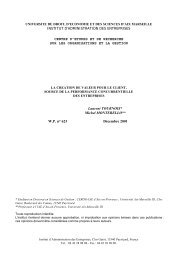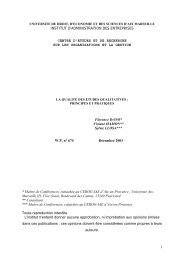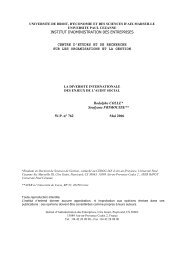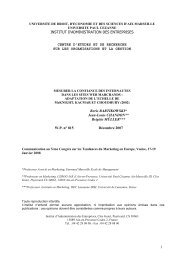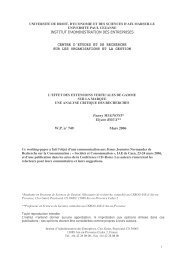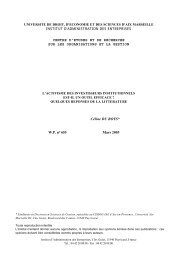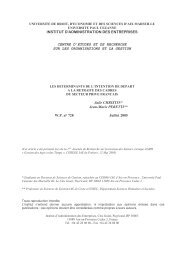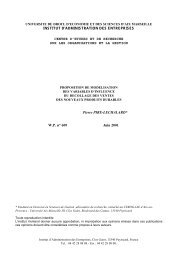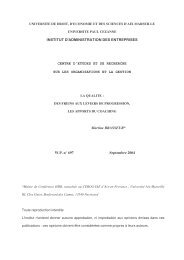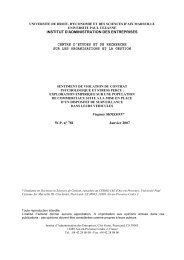INSTITUT D'ADMINISTRATION DES ENTREPRISES ... - cergam
INSTITUT D'ADMINISTRATION DES ENTREPRISES ... - cergam
INSTITUT D'ADMINISTRATION DES ENTREPRISES ... - cergam
You also want an ePaper? Increase the reach of your titles
YUMPU automatically turns print PDFs into web optimized ePapers that Google loves.
UNIVERSITE DE DROIT, D'ECONOMIE ET <strong>DES</strong> SCIENCES D'AIX MARSEILLEUNIVERSITE PAUL CEZANNE<strong>INSTITUT</strong> <strong>D'ADMINISTRATION</strong> <strong>DES</strong> <strong>ENTREPRISES</strong>CENTRE D’ETU<strong>DES</strong> ET DE RECHERCHESUR LES ORGANISATIONS ET LA GESTIONTALK TO YOUR CUSTOMERS :ARE NEWSLETTERS AND CONSUMER MAGAZINESREALLY EFFICIENT ?Laurent FLORES*Brigitte MULLER**Meriem AGREBI***Jean-Louis CHANDON****W.P. n° 808 Septembre 2007*Professor of Marketing, INSEEC, France & Director, Crmmetrix, France & USA**Assistant Professor of Marketing, HEC Business School, University of Lausanne, Switzerland***Doctoral Student, IAE Graduate School of Management, University Paul Cézanne Aix-Marseille III, ClosGuiot, Puyricard CS 30063, 13089 Aix-en-Provence Cedex 2****Professor of Marketing, IAE Graduate School of Management, University Paul Cézanne Aix-Marseille IIIToute reproduction interditeL'institut n'entend donner aucune approbation, ni improbation aux opinions émises dans cespublications : ces opinions doivent être considérées comme propres à leurs auteurs.Institut d’Administration des Entreprises, Clos Guiot, Puyricard, CS 3006313089 Aix-en-Provence Cedex 2, FranceTel. : 04 42 28 08 08.- Fax : 04 42 28 08 00
TALK TO YOUR CUSTOMERS:ARE NEWSLETTERS AND CONSUMER MAGAZINES REALLYEFFICIENT?Laurent Florès, Professor of MarketingINSEEC, France & Director, Crmmetrix, France & USAlflores@crmmetrix.comBrigitte Müller, Assistant Professor of MarketingHEC Business School, University of Lausanne, Switzerlandbrigitte.muller@unil.chMeriem Agrebi, Doctoral StudentIAE Graduate School of Management, University Paul Cézanne, FranceMeriem.agrebi@iae-aix.comJean-Louis Chandon, Professor of MarketingIAE Graduate School of Management, University Paul Cézanne, FranceJean-louis.Chandon@iae-aix.com
RésuméLa croissance rapide d’Internet a conduit à la multiplication des sites de marque. Les achatsrépétés représentent aujourd’hui plus de la moitié des ventes sur le Net (Balabanis et al.,2006). Ces développements du commerce électronique offrent des opportunités en termes destratégie de marque mais nécessitent aussi une meilleure compréhension du comportement denavigation du consommateur. Cette recherche démontre que les visiteurs satisfaits del'expérience globale de visite du site Web ont tendance à revisiter et à recommander le site,ainsi qu’à développer des attitudes positives envers la marque et des intentions d’achat plusélevées. Ces relations sont plus fortes pour les clients qui ont souscrit à des outils demarketing relationnel tels que des magazines consommateurs ou des bulletins d’information.Mots clés : Site de marque, outils de marketing relationnel, satisfaction avec le site, intentiond’achat, stratégie de marque sur Internet.AbstractThe rapid growth of the Internet has multiplied brand and product-related websites and repeatbuys now account for over half of all e-tailer sales (Balabanis et al., 2006). Thesedevelopments offer compelling advantages in terms of branding and e-commerce and call fora deeper understanding of consumer navigation behavior. This research demonstrates thatvisitors satisfied with the overall website experience are more inclined to revisit andrecommend the website and are more disposed to develop positive attitudes toward the brandand purchase intention. These relations are stronger for customers who subscribed torelationship tools such as consumer magazines or newsletters.Key Words: Brand website, Relationship tools, Website satisfaction, website impact onpurchase intent, website impact on branding.
IntroductionIn the first quarter of 2006, US retail e-commerce sales totaled $25.2 billion, an increase of25.4% from the first quarter of 2005 and accounting for 2.6% of total sales (US CensusBureau). Additionally, the number of company websites greatly increased. Today, the largemajority of companies have at least one website for their brands and products, sometimesmore (image website, corporate website, e-commerce website). For these reasons, the rapidgrowth of the Internet offers compelling advantages in terms of e-commerce and branding.However, while traffic to brand websites is important, it has become critical to bothresearchers and practitioners to have a better and deeper understanding of visitors’ navigationand experience online (Peterson et al., 1997). Indeed, traditional tools measuring trafficperformance such as the number of visitors coming to a website and page views are notsufficient anymore (Florès, 2004).In fact, the overall use of the Internet has also evolved. A website describing the technical orfunctional characteristics of the products offered may decrease total consumer search. But asuccessful brand website must offer more than product description to maximize consumerexperience and branding.All in one, this changing environment has triggered renewed research interest regarding theimportance of branding, effective brand building and communication strategies in this newenvironment. Divergent views have emerged: those in favor of reconsidering classic brandingstrategies (Travis, 2001) and those which claim that brand management will take on anincreased role (Chen, 2001); others defend the idea that branding should be less crucialbecause Internet users are better informed than non-Internet users (Sealey, 1999; Sinha,2000).Whatever is the alternative, it remains clear that the Internet represents a new channel ofcommunication and distribution for brands. Its interactive nature offers marketer newopportunities to create stronger brand identities with the potential to induce brand loyalty(Upshaw, 2001). The Internet allows consumers to react and interact, creating a dialogueoutside the managers control (Travis, 2001).In this new environment, a well designed website is no longer sufficient. Delivering asatisfying and valuable experience online is important and may be key to increase favorablebrand perceptions and purchase intent (Florès, 2004).
The aim of this research is twofold. First, we demonstrate that the more satisfied visitors arewith the overall site experience, the more inclined they are to revisit and recommend thewebsite and to develop a positive attitude toward the brand. This first and main objectiveintegrates the presented literature by replicating findings from earlier research (Supphellenand Nysveen, 2001; Hong and Kim, 2004), but extends those results by stressing andsupposing that it is word-of-mouth and the intention to return to the website that bothinfluence brand attitude and purchase intent. Second, we explore how different relationshiptools, such as newsletters and consumer magazines, may further increase website experiencevalue and its impact on brand attitude and purchase intent.The conceptual framework of the present article will first review the changing marketingenvironment and the evolving needs of consumers. Then, we review existing research onwebsite design and its effects on brand attitude and satisfaction. This part will also present theresearch on intention to return to the website and purchase intention. Finally, we finish thisliterature review with a conceptual model that highlights our research hypothesis.A changing environmentRecently, marketers had to cope with a changing environment concerning their companies andbrands. The underlying forces of this changing environment namely relate to the massivedevelopment of hard discounters, the decrease in the number of brands owned by bigcompanies and the rise of the Internet. In this changing landscape, it therefore becomesincreasingly difficult for companies to differentiate their products and brands fromcompetitors. Product and price alone are no longer sufficient in gaining market share and theuse of traditional mass marketing techniques may no longer be adapted to a fast movingenvironment. Establishing a dialog with customers, to understand and anticipate their needs iskey to offer better and personalized products and services (Lewi, 2005). These requirementsare in fact dramatically enhance by the Internet. Efficient and well designed websites are notsufficient any more for attracting customers and making them want to return and substantialamounts are invested nowadays to develop superior websites 1 .In addition to these developments, an increasing number of researchers consider websites asinteractive advertising (Karson and Korgaonkar, 2001; Macias, 2003). Therefore, it isimportant to underline the intrinsic characteristics which distinguish the Internet from1 See for example, research over years from Forrester at www.forrester.com
traditional advertising media. First, the Internet is a rich medium, where a great variety ofinformation is available. Second, "website visitors are in control" (Karson and Fisher, 2005,p.3), which means that visitors choose which sites they wish to visit, when and how long theywant to visit them and even when and how often they are willing to return. Therefore, websitevisit is a voluntary exposure, controlled neither by the advertiser nor the company, but subjectto the pure decision and willingness of consumers and to technical ups and downs. Third, theInternet is an interactive medium, where personal communication and interaction betweencompanies and consumers are unlimited. Finally, the way consumers use the Internet hasevolved. Household equipment with personal computers has grown very fast so that in 2005,there are approximately one billion Internet users around the world, which represents around15% of the total world population (Computer Industry Almanac). The Internet is no longer aninnovation, but has become a normal way to collect information and make purchases. It is nolonger a simple communication tool, but it has become an instrument for entertainment,business and research. Companies and brands have to offer more than just a pleasant and welldesigned website by offering consumers additional services. The objective is not only tosatisfy the customer and compete with other actors offering the same products or services, butmost of all to generate revisits (Supphellen and Nysveen, 2001).Website design and its effects on brand, satisfaction and buying intentionsThe focus of attention in the literature on Internet is increasingly directed to website designand the identification and classification of the different dimensions that compose a website,such as entertainment (Chen and Wells, 1999), interactivity (Ghose and Dou, 1998; Wu,1999; Shankar, Smith and Rangaswamy, 2000), ease of use (Eighmey, 1997), informationcontent (Shankar, Smith and Rangaswamy, 2000), etc.Even if the quality of a website is still a vastly undefined concept, one of the most importantand distinguishing features of the Internet is its interactivity. According to Upshaw (2001), theinteractive nature of the Web offers marketers' new opportunities to create stronger brandidentities that have the potential to translate into brand loyalty. Berthon et al. (1996) suggestthat the level of interactivity on a website is critical in converting website visitors frominterested contacts into interactive customers. By exploring the impact of interactivity on theattractiveness of corporate websites, they add that an increase in the degree of interactivity hasa significant positive effect on web-site attractiveness and quality. A good website designincluding interactivity leads to higher satisfaction because it offers customized informationsearch (Shankar, Smith and Rangaswamy, 2000). It is crucial that a website "holds the
potential to be what traditional advertising has often failed to be - a desired, engaging andpositive form of communication instead of intrusive, annoying, or unwanted" (Macias, 2003).This research shows that interactive advertising positively influences consumers’ perceptionsof brands and advertising. Schmitt (2000) argues that "sites must target the priorities ofspecific customer segments, they must engage users in both active and interactiveexperiences; they must be integrated with other brand elements; and they must be supportedwith quality service". Digital brands are seen as "composed of an increasingly rich array ofsensory experiences".Besides interactivity, numerous articles discuss the effects of websites on brand attitude andintentions variables. For example, brand loyalty (Supphellen and Nysveen, 2001), websitequality (Loiacono, Watson and Goodhue, 2002), entertainment (Raney et al., 2003), flow(Luna, Peracchio and de Juan, 2002), website preference (Rosen and Purinton, 2004), overallsatisfaction with the website (Hong and Kim, 2004), website design and customer service(Wolfinbarger and Gilly, 2003), attitude toward the website (Supphellen and Nysveen, 2001;Karson and Fisher, 2005) or attitude toward the brand (Raney et al., 2003) were identified ashaving a positive effect on intentions to return to the website. In the same way, purchaseintention seems mainly affected by similar variables, including interactivity (Wu, 1999; Yooand Stout, 2001), attitude toward the site (Jee and Lee, 2002), website quality and design(Loiacono, Watson and Goodhue, 2002; Wolfinbarger and Gilly, 2003) and attitude towardthe brand (Raney et al., 2003). Finally, some research has identified determinants of attitudetoward the brand after the website visit, such as interactivity (Wu, 1999; Macias, 2003) andattitude toward the website (Raney et al., 2003).This research focuses mainly on the relation between website satisfaction, loyalty towards thesite, brand attitude and purchase intention. Visitors' overall satisfaction is an indicator of "howwell customers like their experience at the site and it is probably the best indication of theirwillingness to return to the site again" (Jiang and Rosenbloom, 2005, p.159).Most of the studies integrating a satisfaction measure, defined as "a subjective evaluation on apleasant-unpleasant continuum of the consequences of using a website" (Hong and Kim,2004, p.341), explored its antecedents (Bruce, 1999; Ariely, 2000; Shankar, Smith andRangaswamy, 2000; Szymanski, 2000). Satisfaction is for example described by Szymanskiand Hise (2000) as the result of perceived online convenience, merchandising, website designand financial security.
But in the traditional literature on satisfaction (Rust and Zahorik, 1993) and on the Internet(Shankar et al., 2000; Hong and Kim, 2004; Balabanis, Reynolds and Simintiras, 2006), apositive relationship between the overall satisfaction with a service provider and loyalty to theservice provider is identified.In addition, as reported by Lynch, Kent and Srinivasan (2001) and Wolfinbarger and Gilly(2003), the quality or design of a website and appropriate customer service are important toretain the customers and to influence their purchase intentions. The problem is that the loyaltyoutcomes are not always measured by the same variables. Hong and Kim (2004) for exampleuse the customer's intention to visit the website again. On the contrary, Srinivasan, Andersonand Ponnavolu (2002, p.42) define loyalty as "a customer’s favorable attitude toward the e-retailer that results in repeat buying behavior".Following these arguments, the traditional satisfaction literature, and based on the researchexposed above, we reformulate the definition of e-loyalty proposed by Srinivasan et al. (2002)into "a customer’s favorable attitude toward the e-retailer that results in repeat visits andword-of-mouth". We propose that:H1: Overall navigation satisfaction has a positive influence on loyalty behavior.Although this may sound obvious, we believe that satisfaction is a necessary condition toimpact loyalty towards the site even more so in the specific case of the brand website. In ourresearch, overall satisfaction is measured by eight items, evaluating the attractiveness of thewebsite. The loyalty behavior index in our research model is a composed measure of Intentionto return to the website and Intention to recommend the website (word-of-mouth). Therefore,we suppose that:H2: Loyalty behavior has a positive influence on Brand impact index.The variety and number of articles exposed above underline the diversity of the existingresearch, the multiplicity of definitions and variables used to measure the same effects andtherefore the difficulty to clearly identify which measures to retain. It is therefore stillnecessary to acquire greater understanding about the effective promotion of a brand on theInternet (Ibeh, Luo and Dinnie, 2005). The relational potential of this media and its intrinsiccharacteristics changes the traditional service or contact experience because the visitorparticipates more than with any other media in the service encounter. Therefore, by offering agreat consumer experience, a company can enhance its brand image and loyalty (Chang et al.2002). Our second hypothesis will look at providing further evidence to support this fact. Wewill specifically look at demonstrating the influence of loyalty towards the site on branding.
In our model, we define branding through a brand impact index made of a composed measureincluding purchase intent towards the brand (5 point scale) and Change of Opinion towardsthe brand upon website visit.The creation of a new brand experienceMost of the research on websites focused on aspects such as loyalty, satisfaction andconvenience. In this new environment, consumers " have different needs and wants, and theywill go where they are best served" (Burke, 2002, p.427). They need to have a good reason tovisit a website and to visit it again. Researchers agree to say that obtaining the revisit of acustomer is very important, especially because in average, acquiring new customers is moreexpensive than a customers’ lifetime value (Hoffman and Novak, 2000). But fortunately, "theWeb is actually a very sticky space [...and] customers exhibit a clear proclivity towardloyalty" (Reichheld and Schefter, 2000, p.106).In this new environment, every brand has to be transformed into a service brand becauseawareness is not sufficient in the virtual world and four major requirements may be identified:do not waste the time of the visitor; recognize the differences between visitors to orient themrapidly to customized information; consider the website as a store open day and nightprovoking satisfaction and loyalty; and give the opportunity to the consumers to dialog withothers (Kapferer, 2000).The importance today is to build relationships with customers because they buy the brandsthey know and trust. By offering added value through newsletters or consumer magazines, abrand website can shorten this process. These tools "can place the brand in front of consumerson a monthly, weekly of even daily basis. [...] The brand goes from being somethingconsumers only think about periodically when shopping, to a trusted, daily source of categoryinformation" (Florès, 2004, p.27). In addition to this, Richard and Chandra (2005) argue thatthe reasons a customer has to visit a website are positively related to pre-purchase intentions.In consequence, companies invest large amounts of money developing programs andmanagement tools in order to offer additional services and to develop relationships with theircustomers. But their efficiency is not always tested or analyzed.Therefore, this research investigates the impact of relational tools, such as newsletters orconsumer magazines, on consumer behavior. Supposing that consumers highly involved withthe website are more disposed to engage in a more intensive information search on thewebsite (Yoo and Stout, 2001; Richard and Chandra, 2005), they are also more inclined to
"explore more new stimuli and situations because of a higher need for environmentalstimulation" (Richard and Chandra, 2005, p.1022). Following these arguments, and bydefining involvement as "motivational state influenced by a person's perception of the object'srelevance based on inherent needs, values and interests" (Day, Stafford and Camacho, 1995,p.70), we suppose that involved customers should be more prone to subscribe to newslettersor consumer magazines.More precisely, according to the degree of involvement and interest that a consumer expressestoward a brand by subscribing to one of the relational tools developed by the company, hisbehavior in terms of loyalty and purchase intention will not be the same. In other words, weexplore if relationship management tools strengthen the path between loyalty and intentionbehavior. A distinction is made between those who register with a brand's newsletter, thosewho subscribe to the brand's consumer magazine and those who systematically open thenewsletter. Consequently, we suppose that:H3: The more consumers get voluntarily involved with a company or a brand throughrelationship tools, the more they will be interested in recommending and revisiting thewebsite or purchasing products from this company or brand.Research methodologyThe main purpose of this study is to evaluate brand website’s impact on purchase intention.The electronic environment of this research offers the opportunity to achieve this target byasking people about their opinions immediately after a particular website experience. Byusing a methodology called SiteCRM® 2 , visitors are invited to respond to a survey whenleaving the website of a specific brand in the food industry. Using pop up invitations, peoplewere randomly asked to participate in the study. Data are transmitted to a database thatgenerates in real time results on a platform called “EZViews”. This dashboard offers theopportunity to track website performance in terms of quality of website experience and impacton intention to buy and other indicators such as intention to revisit and intention torecommend. Results are restored through graphics and tables and serve as a decision platformfor website managers.The data collection was conducted during two months and a total of 870 surveys werecompleted and analyzed. The questionnaire lasts about 10 minutes and aims at identifying2 For more information on SiteCRM, visit : www.crmmetrix.com
visitor profile (socio-demographic information), motivations for visit, source of visit (onlineadds, search engines, website partners), evaluation of website content, design and quality ofnavigation, intention to buy and overall perception of the brand following website visit.In order to appreciate the added value of additional communication and relationship channels,the data collected was sorted into subgroups. The analyzed relationship tools are a bi-weeklynewsletter and a consumer magazine sent out every three months. The first subgroups make adistinction between magazine subscribers (N=639) and non subscribers (N=231). The seconddistinction consists in separating newsletter subscribers who systematically open it (N=584),subscribers who do not systematically open it (N=91) and non subscribers (N=195).MeasurementsThis study’s proposed model structure is composed of eight observed variables related to thebrand website and three latent constructs that are satisfaction index, loyalty index and brandimpact index.The satisfaction index is a composed measure of overall navigation satisfaction reflected ineight constructs (α=.82). Website visitors were asked to evaluate their satisfaction on a fivepoint Likert scale, from “not at all satisfied” to “very satisfied” concerning the attractivenessof the website on the following items: ease of navigation, interesting content, informationupdate, daily help in managing food habits, interesting promotional offers, personalizedservices/advice, providing information about the brands and events of the group, interestingonline games.Figure 1: Overall measurement modelThe loyalty index is a composed construct of faithfulness to the website (intention to revisitthe website) and word-of-mouth (intention to recommend the website). Finally, brand impact
index is a measure composed of brand opinion change and purchase intention. All theconstructs are measured on five point Likert scales.Analysis and ResultsWe first present our sample and the results of the overall model by exploring the effects of awebsite visit on loyalty towards the site and brand impact. Then, the impact of two differentrelationship tools on the Brand Impact Index is analyzed.Our sample is composed of a vast majority of female visitors (90.6%), aged mainly between25 and 34 (37.6%) and 35 and 44 (29.2%). Most visit the website regularly: 29.7% declarevisiting the website once a week or more and 27.4% every two or three weeks. 92.5% statealso being the person responsible for shopping and 89.2% for cooking.Overall research modelThe hypothesized relationships were tested using structural equation modeling. Chi-square,CFI, GFI, AGFI and Root Mean Square Error Approximation were used to measure goodnessof fit. Results for the proposed model revealed a Chi-square/df value of 3.198, GFI of 0.968,AGFI of 0.952, CFI of 0.956 and a RMSEA of 0.050 (p < 0.46), indicating that the model fitswell and is acceptable. All relationships were positive and significant (p < 0.01), indicatingsupport for the two first hypotheses H1 and H2.Figure 2: Test of the research modelOverall satisfactionSatisfactionindexLoyalty IndexH1IntentionH20.66- to revisit- to recommend0.910.44 0.82Brand Impact IndexBrand opinion changePurchase intentionMultigroup path analysisTo test the hypothesis concerning different Customer relationship management tools,multigroup analysis with Amos were conducted. First, a model in which all paths wereconstrained to be equal in different groups was estimated. Then, an unrestricted model wastested. Comparison between these two types of models allows us to identify the importanceand relative effect of each antecedent in different groups (Banerjee, Iyer and Kashyap, 2003).Results show a significant difference between those who subscribe to the consumer magazineand those who don't (χ 2 26d.f. = 70.07, p
concerning newsletters. In fact, we observe a significant difference between three groups(χ 2 52d.f. = 141.88, p
The major explanation for these results is that the subscription to the two analyzedrelationship tools reflects the interest of the consumer in the brand and its history or recentdevelopments more than toward the website itself. As the loyalty index measures the intentionto return to the website and to recommend it, the effect is weak.These results suggest that additional services, which are offered to consumers in order todevelop more involving and enduring relationships, can be effective in terms of purchaseintention and brand opinion change. By providing higher satisfaction to consumers,"companies have the opportunity to start building relationships with them, strengthening thebrand further and making it more difficult for competitors to imitate” (Ibeh, Luo and Dinnie,2005, p.357).Overall, and from a pure managerial standpoint, research results are encouraging and supportcurrent management practices of increasing investment in website development and support.Indeed, at a time where return on invest for any marketing activity needs to be justified, it isspecifically beneficial for interactive brand managers to be able to “value” the brandingreturns of their brand websites strategies. As stated in the introduction, website traffic andnumber of visits are no longer sufficient to value the true return of websites. This isparticularly true when a website mainly supports branding efforts with only indirect saleseffects because not supporting any direct e-commerce activities. To that end, it is clearlyreassuring that brand website exposure has a branding impact value through purchase intentand brand opinion change. Along the same lines, the impact of satisfaction and loyaltytowards the site on branding effects also speak to the point of interactive brand managers thatwork towards making their websites more “sticky” with a high revisit and recommend values.In fact, this last point is of specific importance as interactive branding strategies should worktowards increasing and driving website loyalty thus brand loyalty. Thus, the first results showthe contribution and impact of relationship tools (the e-newsletter and consumer magazine)and also offer initial support to interactive brand managers.Some limits to this research have to be underlined. First, the measurements of loyalty andbrand impact indexes are based only on two items. Moreover, due to the context of the datacollection, the brand impact index is composed of two different concepts that should not beassociated. This limit has to be nuanced because by analyzing the models with two separateconcepts, the stability of the results could be verified. Second, this research does notdistinguish between consumers who are affiliated to one of the relationship tools for a short ora long time, which could reinforce the differences. Third, we have to underline an implicit
self-selection bias because the sample includes only those who choose to respond to the popupmessage. Finally, some other characteristics should be taken into consideration, like trustor involvement with the product category, and other types of websites should be analyzed.Further research should not only look at expanding the present research limitations but shouldopen future research to specifically look at how website elements drive higher satisfaction thatin turn leads to higher website loyalty thus branding impact. To that end, it is particularlyinteresting and useful for managers to pinpoint the particular variables and website tactics thathave the biggest impact on branding. In other words, it is of great value to equip managerswith an adequate tool for measuring and valuing website features that may bring the biggestReturn on investment. This type of approach has been proven successful for example with theuse of the American Customer Satisfaction Index (ACSI) 3 , a uniform and independentmeasure of household consumption experience, which tracks trends in customer satisfaction.However, in the case of website branding effects, specific attention should be given towardsmodeling branding impact and the relative contribution of specific website features andrelationship tools. Empowered by such approaches and models, interactive brand managerswill therefore have a powerful tool for piloting website growth and business impact.3 For more information : www .acsi.org
ReferencesAriely D. Controlling the information flow: Effects on consumers’ decision making andpreferences. Journal of Consumer Research 2000; 27 (2): 233-248.Balabanis G., Reynolds N., Simintiras A. Bases of e-store loyalty: Perceived switchingbarriers and satisfaction. Journal of Business Research 2006; 59: 214-224.Banerjee S.B., Iyer E.S., Kashyap R.K. Corporate Environmentalism: Antecedents andInfluence of Industry Type. Journal of Marketing 2003; 67 (April): 106-122.Berthon P., Leyland P.F., Watson R.T. The World Wide Web as an Advertising Medium:Toward an Understanding of Conversion Efficiency. Journal of Advertising Research 1996;36 (1): 43-54.Bruce H. Perceptions of the Internet: what people think when they search the Internet forinformation. Internet Research: Electronic Networking Applications and Policy 1999; 9 (3):187-199.Burke R.R. Technology and the customer interface: What Consumers want in the physical andvirtual Store. Journal of the Academy of Marketing Science 2002; 30 (4): 411-432.Chang J.E., Simpson T.W., Rangaswamy A., Tekchandaney J.R. (2002). A Good Web SiteCan Convey the Wrong Brand Image! A Preliminary Report. eBusiness Research Center,Pennsylvania State University, Working Paper, University Park, PA.Chen Q., Wells W.D. Attitude toward the site. Journal of Advertising Research 1999; 39 (5):27-37.Chen S. Assessing the impact of the Internet on brands. Journal of Brand Management 2001;8 (4-5): 288-302.Computer Industry Almanac, www.c-i-a.com
Day E., Stafford M.R., Camacho A. Research Note: Opportunities for Involvement Research:A Scale-Development Approach. Journal of Advertising 1995; 24 (3): 69-75.Eighmey J. Profiling user responses to commercial Web sites. Journal of AdvertisingResearch 1997; 37 (3): 59-66.Florès L. 10 facts about the value of brand websites. Admap 2004; (February): 26-28.Ghose S., Dou W. Interactive Functions and their impacts on the appeal of Internet PresenceSites. Journal of Advertising Research 1998; 38 (2): 29-43.Hoffman D.L., Novak T.P. How to acquire customers on the Web. Harvard Business Review2000; 78 (3): 179-188.Hong S., Kim J. Architectural criteria for website evaluation - conceptual framework andempirical validation. Behaviour & Information Technology 2004; 23 (5): 337-357.Ibeh K.I.N., Luo Y., Dinnie K. E-branding strategies of internet companies: Some preliminaryinsights from the UK. Journal of Brand Management 2005; 12 (5): 355-373.Jee J., Lee W-N. Antecedents and Consequences of Perceived Interactivity: An ExploratoryStudy. Journal of Interactive Advertising 2002; 3 (1).Jiang P., Rosenbloom B. Customer intention to return online: price perception, attribute-levelperformance, and satisfaction unfolding over time. European Journal of Marketing 2005; 39(1/2): 150-174.Kapferer J-N. Re-marques. Les marques à l’épreuve de la pratique, Paris: Ed. D’Organisation,2000.Karson E.J., Fisher R.J. Predicting intentions to return to the web site: extending the dualmediation hypothesis. Journal of Interactive Marketing 2005; 19 (3): 2-14.
Karson E.J., Korgaonkar P.K. An Experimental Investigation of Internet Advertising and theElaboration Likelihood Model. Journal of Current Issues and Research in Advertising 2001;23 (Fall): 53-72.Lewi G. Branding management. La marque, de l’idée à l’action. Paris: Pearson Education,2005.Loiacono E.T., Watson R.T., Goodhue D.L. Webqual: a Measure of Website Quality.American Marketing Association 2002; (Winter): 432-438.Luna D., Peracchio L.A., de Juan M.D. Cross-Cultural and Cognitive Aspects of Web SiteNavigation. Journal of the Academy of Marketing Science 2002; 30 (4): 397-410.Lynch P.D., Kent R.J., Srinivasan S. The global Internet Shopper: Evidence from ShoppingTasks in Twelve Countries. Journal of Advertising Research 2001; 41 (3): 15-23.Macias W.A. Preliminary Structural Equation Model of Comprehension and Persuasion ofInteractive Advertising Brand Web Sites. Journal of Interactive Advertising 2003; 3(2).Peterson R.A., Balasubramanian S., Bronnenberg B.J. Exploring the implications of theInternet for consumer marketing. Journal of the Academy of Marketing Science 1997; 25 (4):329-346.Raney A.A., Arpan L.M., Pashupati K., Brill D.A. At the movies, on the web: an investigationof the effects of entertaining and interactive web content on site and brand evaluations.Journal of Interactive Marketing 2003; 17 (4): 38-53.Reichheld F.F., Schefter P.E-Loyalty: Your Secret Weapon on the Web. Harvard BusinessReview 2000; 78 (4): 105-113.Richard M-O., Chandra R.A model of consumer web navigational behavior: conceptualdevelopment and application. Journal of Business Research 2005; 58: 1019-1029.
Rosen D.E., Purinton E. Website design: Viewing the web as a cognitive landscape. Journalof Business Research 2004; 57: 787-794.Rust R., Zahorik A. Customer Satisfaction, Customer Retention, and Market Share. Journal ofRetailing 1993; 69 (2): 193-216.Schmitt B. Creating and managing brand experience on the Internet. Design ManagementJournal 2000; 11 (4): 53-58.Sealey P. How E-commerce will trump brand management. Harvard Business Review 1999;(July-August): 171-176.Shankar V., Smith A.K, Rangaswamy A. Customer Satisfaction and Loyalty in Online andOffline Environments. eBusiness Research Center, Working Paper 02-2000 (October),Pennstate.Sinha I. Cost transparency: the Net's Real Threat to Prices and Brands. Harvard BusinessReview 2000; 78 (2): 43-50.Srinivasan S.S., Anderson R., Ponnavolu K. Customer loyalty in e-commerce: an explorationof its antecedents and consequences. Journal of Retailing 2002; 78: 41-50.Supphellen M., Nysveen H. Drivers of intention to revisit the websites of well-knowncompanies. International Journal of Market Research 2001; 43 (3), 341-352.Szymanski D.M., Hise R.T. e-Satisfaction: An Initial Examination. Journal of Retailing 2000;76 (3): 309-322.Travis D. Branding in the Digital Age. Journal of Business Strategy 2001; 22 (3): 14-18.U.S. Census Bureau of the Department of Commerce, 18 May 2006,http://www.census.gov/mrts/www/data/html/06Q1.htmlUpshaw L.B. Building a brand.comm. Design Management Journal 2001; 12(1): 34-39.
Wolfinbarger M., Gilly M.C. eTailQ: dimensionalizing, measuring and predicting etailquality. Journal of Retailing 2003; 79 (3): 183-198.Wu G. Perceived Interactivity and Attitude toward Website. 1999 Annual Conference of theAmerican Academy of Advertising, Albuquerque, New Mexico, 1-22,http://www.ciadvertising.org/studies/reports/info_process/perceived_interactivity.htmlYoo C.Y., Stout P.A. Factors affecting users’ interactivity with the web site and theconsequences of users’ interactivity. American Academy of Advertising 2001; Villanova(PA), Villanova University: 53-61
AppendixAppendix 1: Mean differences between variables within groupsGeneralMeanYes(639)MagazineNo(231)Revisit 4.73 4.79 4.58 31.565F, p Nop=.000Recommend 4.27 4.34 4.07 19.143p=.000Loyalty 4.50 4.56 4.32 29.810p=.000Purchase Intention 2.88 2.95 2.67 32.802p=.000Opinion Change 3.55 3.54 3.56 .079Brand impact 3.21 3.253.12p=.77910.742p=.001(195)Yes (91)no openingNewsletterYes (584)openingF, p4.55 4.55 4.82 30.674,(a, b)p=.0004.08 3.99 4.37 15.875,(a, b)p=.0004.32 4.27 4.59 26.458,(a, b)p=.0002.85 2.79 2.89 1.282,p=.2783.51 3.38 3.58 3.386,3.18p=.034 (a)3.09 3.24 3.784,p=.023 (a)Significant between (a) systematic and non systematic opening, (b) systematic opening and not receiving, (c) non systematic opening and notreceiving




